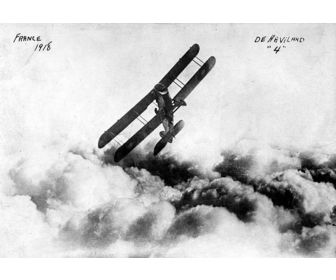Airco DH.4

The Airco DH.4 was a British two-seat biplane day-bomber of the First World War. It was designed by Geoffrey de Havilland (hence DH) for Airco and was the first British two seat light day-bomber to have an effective defensive armament. It first flew in August 1916 and entered service with the Royal Flying Corps (RFC) in March 1917. The majority of DH.4s were actually built as general purpose two-seaters in the USA for service with the American forces in France.
* Fixes bugs in the Airco DH.4 and adds two textures for it, one
American, one British.1
Airco DH-4 (1916) 1449 made in UK and 9500 in US
Airco DH-9 (Improved DH-4 with cockpits togther)
Armstrong-Whitworth FK-8
Breuget 2
Airco DH-4: British two-seater bomber first introduced in 1917.
Airco DH-5: British biplane fighter introduced in 1917 and often used
as a ground attack weapon.3
Airco DH.4 - 1916 - Single-engined piston biplane day-bomber
Airco DH 5 - 1916 - Single-engined piston biplane fighter
Airco DH.4
comprised of Airco DH.4 aircraft and was due to fly day bomber
operations but never saw action in the Great War.5
De Havilland designed the Airco DH-4 in 1916 as a single-engined
bomber and was so impressive in trials that it went into immediate
production.6
Fixes bugs in the Airco DH.4 and adds two textures for it, one
American, one British.
Operating System Support: Mac OS X 10.5 Intel, Mac OS X 10.7
His first confirmed victory was an Airco DH 4 that he shot down on 8th
August 1917.
Bolle was promoted to command Jasta 2 in January 1918.8
Made by Airco.
Airco DH.4 is the predecessor of the Airco DH.9.Airco DH.9A.Dayton-Wright Cabin Cruiser.
remembered for making the AIRCO DH 4 tandem two seat bomber whose
performance was more superior to most fighters at the time when it was
fitted with the R.R.9
the Airco DH-4 biplane, the 23rd BS has flown the B-52 since 1959.
"The B-52s of the 23rd BS have been instrumental to the Air Force
mission," said 1st Lt.10
The Airco DH.4 was a British two-seat biplane day-bomber of the First
World War.11
The Airco DH.4 was a two-seat biplane day bomber that entered service
with the Royal Flying Corps in 1916.12
who was killed on June 19, 1918, in the crash of his Airco DH.4 at
Wilbur Wright Field.13
Wings of War Miniatures II: AIRCO DH 4 - American Expeditionary Force
Wings of War Miniatures II: AIRCO DH 4 - American Expeditionary Force
$10.14
50 - Airco DH-4 Poster by Dividenda see on
3 products- Not for me View details Add to wishlist Got it! We won't
show you this product again!
Undo 15
More Users
Royal Naval Air Service
United States Army Air Service
Height Main
11.0
Height Alt
3.35 m
Length Alt
9.35 m
Jet Or Prop
prop
Range Main
470 mi
Loaded Weight Main
3472.0
Max Speed Alt
230.0
Type Of Prop
inline liquid cooled piston
Endurance
3
Crew
2
Loading Main
8
Power/mass Main
388.79999999999995
Introduction
March 1917
Bombs
460
Max Speed Main
143 mph
Ceiling Main
22000.0
Number Built
1449
Successor
Airco DH.9
Airco DH.9A
Dayton-Wright Cabin Cruiser
Max Speed More
at sea level
Retired
1932
Unit Cost
11250.0
Loaded Weight Alt
1578.0
Area Main
434.0
Primary user
Span Alt
13.21 m
Plane Or Copter?
Power Alt
289.0
Engine(prop)
Rolls-Royce Eagle VII
Manufacturer
First Flight
August 1916
Climb Rate Main
1000.0
More Performance
540.0
Number Of Props
1
Power/mass Alt
Guns
Forward-firing .303 in Vickers machine gun
Lewis gun on Scarff ring at rear
Climb Rate Alt
18300.0
Variants With Their Own Articles
Airco DH.9
Airco DH.9A
Dayton-Wright Cabin Cruiser
Length Main
934.72
Span Main
43
Area Alt
40 m²
Range Alt
770.0
Power Main
375 hp
Related
*Airco DH.9*Airco DH.9A
Empty Weight Main
2387.0
Ceiling Alt
6
700 m
Category
Empty Weight Alt
1085.0
Loading Alt
40
